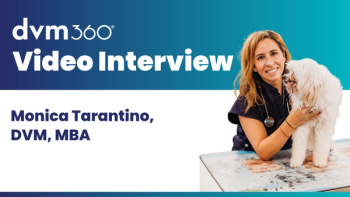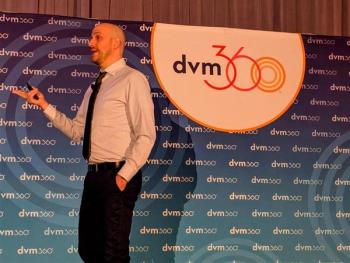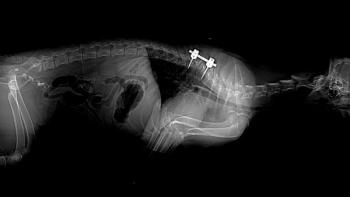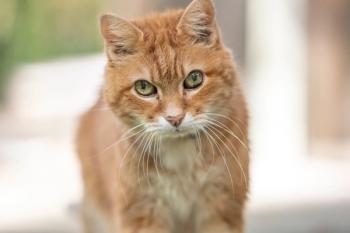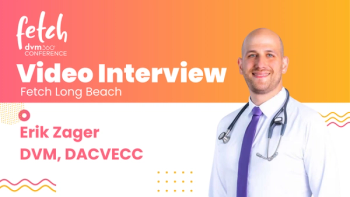
- dvm360 September-October 2025
- Volume 56
- Issue 5
- Pages: 11
Before we were veterinary professionals, we were pet parents
From the CVO: Adam Christman, DVM, MBA, provides commentary about celebrating the professional wins.
We knew what it felt like to sit in a lobby, heart pounding, waiting for news. We knew the helplessness of holding a trembling dog and the anxiety of coaxing a cat into a carrier. We have cried in exam rooms. We have questioned estimates. We have worried about outcomes.
We have been them because we are them.
Walk into any veterinary clinic on a busy Tuesday afternoon, and you will see what our profession has become: ringing phones, full schedules, emergencies, walk-ins, and exhausted teams moving at a sprint pace to keep up. In that whirlwind, the core of why we do this work gets buried under medical records, billing disputes, and endless to-do lists.
Here’s the truth that keeps me grounded: before we were veterinarians, technicians, managers, or receptionists, we were pet parents. That realization that we share the same love, fear, and hope as the people who walk through our doors may be the most powerful reminder we have when the weight of this profession feels unbearable.
I will never forget the day my first dachshund, Chelsea, deteriorated rapidly. Suddenly, I wasn’t Dr Christman with the letters after my name; I was Adam, scared out of my mind, staring at a consent form I did not want to sign but had to. I read DNR forms and prayed for a good outcome. In that moment, every lecture I had ever given about empathy and every note I had written about client communication came roaring back with crystal-clear intensity. I wasn’t thinking like a clinician. I was thinking like a dog dad. Will she walk again?
The veterinary team was incredible, and Chelsea fully recovered after a hemilaminectomy. I wanted reassurance. I wanted compassion. I wanted someone to tell me they would care for my baby girl like she was their own. And I needed to know she was going to be OK. That’s when it hit me: our clients want the exact same things we want, to know their pet is safe, loved, and seen, not just treated as a case but treasured as family.
Think back to the first time you said aloud, “I want to be a veterinarian,” or “I want to be a veterinary technician.” It probably wasn’t because you were fascinated by practice management or eager to navigate third-party payment options.
It wasn’t because you loved 12-hour shifts or wrangling online reviews. It was because of a pet—the childhood dog that got you through hard years, the stray cat that followed you home, the horse that taught you patience, or the rabbit that showed you gentleness. That human-animal bond was the spark. That was our why.
Somewhere between board exams, production goals, and burnout, we forget. It happens. The statistics do not lie. Burnout, compassion fatigue, and moral distress run rampant. The weight of being a healer, counselor, businessperson, and miracle worker all at once is crushing. Add the rising cost of veterinary care, client frustrations, and the grief we absorb every day, and it is no wonder many of us feel like we are drowning.
But here’s the lifeline: our why is still there. It has not left us. It is buried beneath the noise.
We do not get to choose how long our patients live. We do not always get to decide whether a client says yes to treatment. But we do get to choose how we show up—and how deeply we remember that we are in this together as professionals and as pet parents. I save every sympathy card, every thank-you note, and every Edible Arrangements delivery to help me know my why. I suspect you do the same. After you finish reading this, revisit those cards and notes and look at the great work you have accomplished and continue to accomplish.
Here is a perspective shift that changes everything:
- When a client balks at an estimate, remember when you stared at a surgery bill and wondered how you would manage it.
- When a client asks the same question 3 different ways, remember the time you clung to every word from your own clinician, desperate for reassurance.
- When a client becomes emotional over “just a skin tag,” remember when your pet trembled and you wanted nothing more than to protect them.
It is not “us” vs “them.” It is “we.” It always has been and always will be. In the words of The Mandalorian, “This is the way.”
We are them, and they are us.
So how do we keep the spark alive when exhaustion threatens to snuff it out and we sit in our cars scrolling on our phones in the driveway before going inside? A few practical reminders:
- Tell the stories. Share the moment your pet changed your life with your team.
- Ask them to pause for perspective. Before every appointment, imagine you are the client, not the clinician. What would you want to feel in that moment? This can be daunting during long shifts and in emergency medicine, but it is not impossible.
- Lead with empathy. Empathy is not a script but a recognition: “I have been where you are. I know this is hard.”
- Celebrate the wins. A wagging tail, a purr, a regular urine stream after cystotomy, a grateful smile—those are victories. Let them matter.
- Give yourself grace. You cannot pour from an empty cup. Caring for yourself is part of caring for your patients. Be good to yourself, your family, and your friends.
Every profession has a purpose, but few carry the weight of love like ours. We are guardians of the bond between people and their animals. That is not just medicine; it is sacred.
When you are tired, when you are overwhelmed, when the noise feels deafening, come back to this truth:
- Before we were veterinarians, we were pet parents.
- Before we were healers, we were the ones praying for healing.
- Before we carried the stethoscope, we carried the leash, the carrier, and the toy in the waiting room.
That is what unites us, not just as a profession but as people.
The next time you walk into an exam room, take a breath and look at the client sitting there. See yourself in them. Remember what it feels like to be on the other side of the table. Then remind yourself of your why.
At the end of the day, this is not about production or protocols. It is about love, about the bond that brought us here in the first place.
At the end of every shift, after the charts are closed and the lights go off, what stays with us is not the stress or the numbers but the memory of the lives we touched and the quiet reminder that every patient we heal could easily be our own.
Articles in this issue
about 1 month ago
The role of diet in feline diabetes mellitusabout 2 months ago
Managing equine back painabout 2 months ago
Incorporating disaster readiness in a veterinary facilityabout 2 months ago
Products+Services360: Veterinary Spanish guide & other products2 months ago
Shortening scheduling callsNewsletter
From exam room tips to practice management insights, get trusted veterinary news delivered straight to your inbox—subscribe to dvm360.


